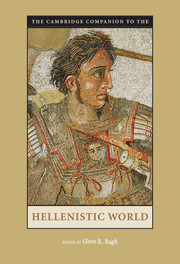Book contents
- Frontmatter
- Introduction
- 1 Alexander the Great and the Creation of the Hellenistic Age
- 2 The Hellenistic Kingdoms
- 3 The Polis and Federalism
- 4 Hellenistic Economies
- 5 The Hellenistic Family
- 6 History and Rhetoric
- 7 Material Culture
- 8 Hellenistic Art: Two Dozen Innovations
- 9 Language and Literature
- 10 Greek Religion: Continuity and Change in the Hellenistic Period
- 11 Philosophy for Life
- 12 Science, Medicine, and Technology
- 13 Hellenistic Military Developments
- 14 Greeks and Non-Greeks
- 15 Recent Trends and New Directions
- Hellenistic Dynasties
- Works Cited
- Index
8 - Hellenistic Art: Two Dozen Innovations
Published online by Cambridge University Press: 28 November 2007
- Frontmatter
- Introduction
- 1 Alexander the Great and the Creation of the Hellenistic Age
- 2 The Hellenistic Kingdoms
- 3 The Polis and Federalism
- 4 Hellenistic Economies
- 5 The Hellenistic Family
- 6 History and Rhetoric
- 7 Material Culture
- 8 Hellenistic Art: Two Dozen Innovations
- 9 Language and Literature
- 10 Greek Religion: Continuity and Change in the Hellenistic Period
- 11 Philosophy for Life
- 12 Science, Medicine, and Technology
- 13 Hellenistic Military Developments
- 14 Greeks and Non-Greeks
- 15 Recent Trends and New Directions
- Hellenistic Dynasties
- Works Cited
- Index
Summary
In his second essay On the Fortune or Virtue of Alexander (Moralia 333D-F), Plutarch presents his readers with a problem. Was it Alexander’s good luck that blessed him with such extraordinarily talented artists - Lysippos, Apelles, Pyrgoteles, Deinokrates? Or was it their extraordinary good luck that they lived during his reign, caught his eye, and could profit from his largesse? Was the creation of what we call Hellenistic art ultimately attributable to them or to Alexander?
This is a chicken-and-egg problem, and Plutarch knew it. The fourth century b.c. was not the nineteenth or twentieth centuries a.d., and Lysippos, Apelles, and their peers were not Monet, Rodin, or Picasso. Usually produced on commission, Greek art was the result of four-way negotiation among patron, artist, context, and genre. No innovation appeared out of the blue, the handiwork of a lone, creative genius. All of them had a history.
Yet Plutarch’s rhetoric conceals a deeper truth. Greek art did change profoundly under Alexander, and the invigorating combination of an audacious, opinionated, and uniquely successful young king and a set of supremely talented artists certainly had much to do with it. So the fact that some of the period’s innovations had important classical antecedents is essentially irrelevant. Antecedents can help us to measure and contextualize innovations, but they can neither explain them nor exhaust their meaning.
- Type
- Chapter
- Information
- The Cambridge Companion to the Hellenistic World , pp. 158 - 185Publisher: Cambridge University PressPrint publication year: 2006
- 9
- Cited by

